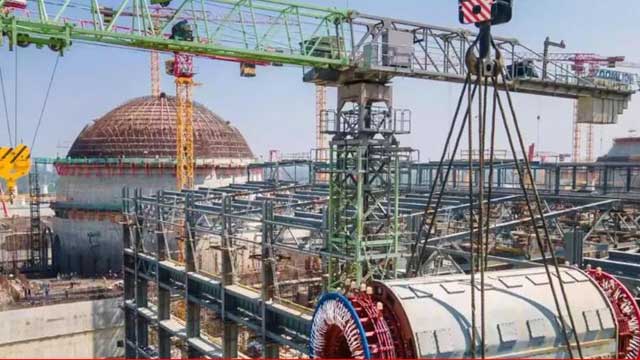With just ten months left to meet the July 2024 deadline set for commencing the operation of the 1200 MW first unit of the Rooppur Nuclear Power Plant (RNPP), officials in the power sector are flagging concerns over severe lags witnessed in implementing the essential transmission infrastructure-related projects.
Provided the power plant remains on track for the stated deadline, officials are now looking at upto a year, maybe even a bit more than that, before the first of its two units - each 1200 MW - as planned, can be commissioned.
Sources at both the Bangladesh Atomic Energy Commission (BAEC) and the Power Grid Company of Bangladesh (PGCB) said that even if the power plant itself is ready by July next year, it would be rendered useless by the lack of requisite transmission lines to carry the power generated at the plant to households or other establishments across the country.
The BAEC is entrusted with the implementation of the country’s maiden nuclear power project while PGCB is responsible for power evacuation and transmission from power plants. This is the first time they are involved in transmission of power generated at a nuclear power plant.
“We’ve been facing three major challenges in completing our preparation for power transmission from the RNPP project,” a highly-placed source at PGCB told UNB, requesting anonymity.
The three challenges he named are construction of river crossing lines, setting up substations, and frequency adjustment.
The senior official said the power transmission lines require two river crossings—9-km over the Jamuna River and 7-km over the Padma.
“Two separate projects have been undertaken by PGCB recently in this regard, and it will take at least two years to complete the projects,” he maintained.
The source explained that the electricity from the RNPP will come to Dhaka through a 400 kV transmission double circuit line, which will be connected with a new 230/132kV grid-substation in Dhamrai.
Recently a firm was awarded the contract to install the transmission line, and its work is still in the preliminary phase. The project is expected to take around 2 years to be completed, pushing the readiness of transmission infrastructure deep into 2025.
“The biggest challenge will be maintaining frequency in the power transmission system from the RNPP project, as it will be a totally new kind of electricity where there will always be a stable demand in transmission and supply network,” a PGCB official told UNB, again on condition of anonymity to discuss the highly sensitive issue.
He would reveal that considering the critical importance of the project, the PGCB had hired a consultant from Russia to work in this regard.
But following the start of the Russia-Ukraine war in February 2022, the consultant suddenly left the country without informing anybody, which put them in a bind.
“Now a high level team is planning to visit Russia to find a solution,” he said.
Science and Technology Minister Yeafesh Osman admitted to a kind of uncertainty over the timely start of power evacuation and transmission from RNPP, telling that his ministry is still in the dark over whether the necessary transmission infrastructures will be ready or not by July 2024.
SIfting through official documents available on PGCB’s official website, it was learned that to ensure power evacuation from RNPP and for the integration and safe operation of Rooppur Nuclear Power Station, and qualitative upgradation of Bangladesh power system, a Tk 10,981.74 crore project titled; ‘Infrastructure Development for Power Evacuation Facilities of Rooppur Nuclear Power Plant’ was undertaken, utilising Indian Line of Credit.
Included in the project is the construction of a 464-km 400 kV Transmission line including 13-km river crossing, a 205-km 230 kV Transmission Line including 7-km river crossing, four 400 kV Bay Extensions, and five 230 kV Bay Extensions.
Implementing the frequency control and frequency drop protection, protection system, emergency control system and other associated tasks for “qualitative upgradation of Bangladesh Power System” is also part of the project.
The present status of the project, according to an updated progress report on the website, is 65 percent physical, i.e. any construction, and 48 percent financial, which tells us how much of the money allocated has been disbursed.
An official of the PGCB said that the 464-km 400 kV Transmission line with its 13-km river crossing, comprises 150-km Rooppur-Dhaka, 154-km Rooppur-Gopalgonj, 90-km Rooppur- Bogura and 51-km Kaliakoir-Aminbazar transmission lines.
The 205-km 230 kV Transmission Line with its 7-km river crossing includes sections of the 158-km Rooppur-Dhaka and 81-km Rooppur-Baghabari lines.
PGCB officials said the progress in installation of transmission lines over land is about 70 percent, but the work on the most challenging aspect, building the river crossings has not even started. The most challenging aspect is





